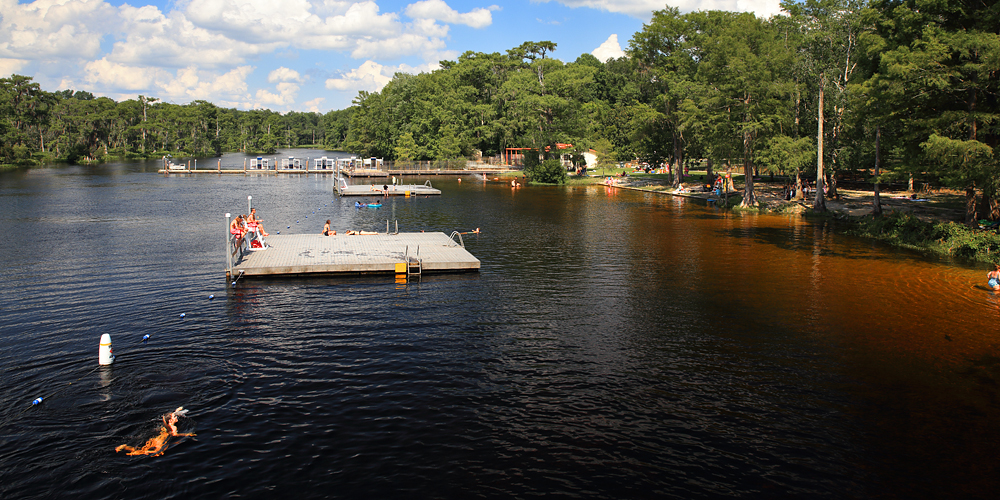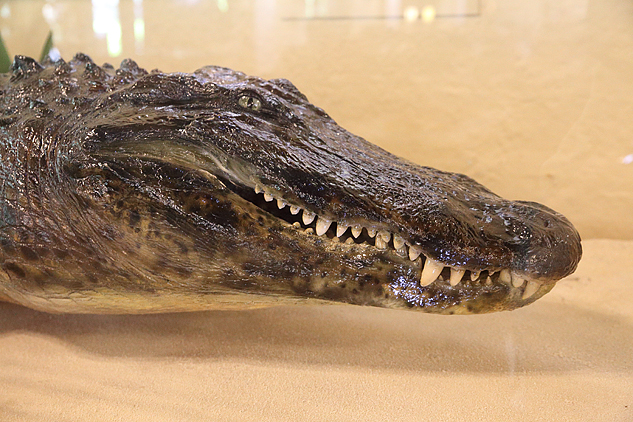
Tag line from The Creature from the Black Lagoon: “Centuries of passion pent up in his savage heart!” The movie starred Julie Adams and Richard Carlson as archaeologists who discover a prehistoric gill-man/monster (played by Ben Chapman) while on an expedition deep in the Amazon.
Excerpt from Visiting Small-Town Florida, 4th Edition:
Wakulla Springs claims the title of largest and deepest spring in the world. Its waters are so clear that the bottom—185 feet down, can usually be seen from the surface. Universal Studios chose Wakulla Springs as the filming location for their 1954 sci-fi/horror classic The Creature from the Black Lagoon, because of its exceptionally clear waters.
It has also been the site of numerous significant archeological excavations. Divers discovered a complete mastodon skeleton at the bottom of the spring in 1935. The mastodon now stands, reconstructed, in the Museum of Florida History in Tallahassee.
All manner of creatures thrive in the park. Alligators, deer, raccoons, and even a few bears live here. But Wakulla Spring’s most famous creature was Old Joe, an eleven-foot-long alligator. Old Joe was first spotted at the springs in the mid-1930s, while the Wakulla Springs Lodge was being built. Over the decades he had gained a reputation as a docile old gator that never bothered anyone. But in 1966 someone shot and killed him. Old Joe was estimated to be 200 years old. Carl Buchheister, then president of the Audubon Society, offered a $5000 reward for information leading to the arrest of the gunman, but none was ever found. Old Joe was stuffed and lives on in a glass case in the Wakulla Springs Lodge lobby. His plaque reads, “Old Joe’s first and only cage.”

Edward Ball was the brother-in-law of Alfred I. DuPont. One of Ball’s proudest achievements was the construction of the Wakulla Springs Lodge in 1937. He was also the executor and trustee of DuPont’s sizable estate and trust. Ball built a banking, telephone, railroad, and paper and box manufacturing empire out of the trust—worth an estimated $33 million in 1935 when DuPont died. Ball had grown that into more than $2 billion by the time he passed away in 1981, at age ninety-three.
The twenty-seven-room lodge is essentially the same today as it was in the 1930s. Ball insisted that it always continue to reflect that era, and he also insisted that it never become so exclusive that it would not be affordable to “common folks”.

Wakulla Springs Lodge reminds me of a palatial Spanish hacienda. The first thing that caught my eye, when I walked into the lobby, was the cypress ceiling beams with Aztec-style hand-painted designs on them. Blue and gold Spanish tiles frame the entrance-way. The floors are checkerboard mauve red and gray Tennessee marble tiles. A giant fireplace, made from native limestone and trimmed in marble, dominates the far wall. Just past Old Joe’s case is the soda fountain shop. There is no bar in the Wakulla Springs Lodge. Instead, Ball, who was fond of ginger whips (ice cream, ginger ale, and whipped cream), had a sixty-foot-long solid marble soda fountain counter installed.

The lodge and grounds sit on the north bank of the springs. From the top of the twenty-foot-high diving platform you can look down into the astonishingly-clear water and see bream and bass schooling on the bottom. It’s no wonder that Hollywood came to this location, not only to film Creature from the Black Lagoon, but also several Tarzan features, Around the World Under the Sea, and Airport 77.
Visiting Small-Town Florida, 4th Edition available at your favorite local book store, or order online at:
Amazon Barnes & Noble Books-A-Million
Bruce Hunt
